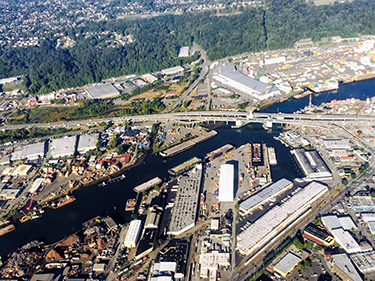|
Subscribe / Renew |
|
|
Contact Us |
|
| ► Subscribe to our Free Weekly Newsletter | |
| home | Welcome, sign in or click here to subscribe. | login |
Environment
| |
 |
September 27, 2018
Accelerating cleanup with adaptive management
Farallon Consulting

Moody
|
The cleanup and restoration of the Lower Duwamish Waterway and Harbor Island has been a long-time goal for the Seattle area.
Since the Harbor Island Superfund site was listed on the National Priorities List in 1983, cleanup efforts have bridged several stakeholders, multiple sites and decades of work. We are nearing the home stretch with cleanup decisions in place everywhere besides the East Waterway Operable Unit. Concurrently, natural resource trustees are evaluating restoration options, and issued an injury assessment plan in July.
At this juncture, stakeholders have an opportunity to use a technique called adaptive management to accelerate cleanup and restoration.
Adaptive management has a long history of usefulness in evaluating complex resource systems to identify the ways in which complex food webs react to and overcome uncertainties in the cleanup process. Although stakeholders have raised objections about the uncertain costs and time frames inherent in this approach, these concerns can be alleviated by building trust and providing a specific path forward for further work based on monitoring.
In short, adaptive management reduces uncertainty with management decisions.
What is adaptive management?
Adaptive management is used in business, environmental science and industrial ecology. Its approach is built on the concept that complex resource systems like those at Superfund sites are only partially understood at the outset. Rather than delaying action until “enough” is known about a system, adaptive management supports action in the face of the uncertainties and complexities of large ecosystems.
Adaptive management is not, however, a trial-and-error approach, nor is it classical experimental science. Essentially, adaptive management is a decision framework that describes one or more series of actions that are selected based on the previous cycle of study results.
Adaptive management has been formally used in environmental management theory since the late 1970s to evaluate forest management approaches, determine the impact of harvesting on fish populations, and identify the intersection of social and ecological systems.
Contaminated-site managers adopted the theory in the 2000s and it has been included in numerous guidance documents such as the 2002 U.S. Environmental Protection Agency Principles for Managing Contaminated Sediment Risks at Hazardous Waste Sites, and several EPA directives and memoranda. Adaptive management was also included in the restoration plan and guidance document for the Deepwater Horizon spill as recently as January.
Why use it?
There are inherent uncertainties in large-scale cleanup and restoration projects. Uncertainties typically encountered in sediment sites include ongoing sources of contamination, estimates of bioaccumulation and magnification for ecological receptors, and the predicted effectiveness of restoration alternatives.
These and other uncertainties cause decision paralysis, when stakeholders believe there is only one chance to find the correct solution. The traditional approach is to select a highly conservative remedy that seems most certain to achieve the objectives.
These conservative methods are less successful, however, in accounting for a project’s inherent uncertainties. Even after a conservative remedy has been selected and implemented, the actual protectiveness of the remedy may not be known until construction is complete.
Adaptive management could support implementation of an active solution following a round or two of data collection, and could prevent or minimize the need to investigate further and postpone cleanup or restoration.
As an example, natural resource trustees identified 23 different studies that need to be conducted in the Lower Duwamish Waterway to identify restoration alternatives while recognizing that significant uncertainties could remain. An adaptive management approach could allow restoration to begin sooner, with studies then performed to reduce those uncertainties in the context of a particular restoration solution.
These actual measured effects make a much more compelling case to stakeholders than modeled effects.
Implementation concerns
Although adaptive management is often the most efficient and effective approach at sites with uncertainty, the dynamic nature of adaptive management can conflict with the desire for a firm schedule and cost. It can be difficult to convince the public and stakeholders to take interim steps, especially if public resources are involved. Decision-makers resist committing time and money to a process that advocates action despite uncertainty or may view an admission of uncertainty as an admission of weakness.
Typical concerns about the use of adaptive management include:
• Uncertain time frame. How many cycles of active management and monitoring events are needed before the work is complete?
• Uncertain costs. Actions selected on the first round of work may or may not be enough.
Solutions
Problem: Lack of trust between stakeholders leads to a push for a more final solution.
Solution: Create a work group approach with a central goal of preparing and using a conceptual site model to discuss how risk-management decisions should be addressed. The framework of a conceptual site model provides a common base around which to focus the discussions and allows a more cooperative approach.
Problem: Potentially responsible parties are often reluctant to agree to a settlement when the total cost of the remedy is uncertain.
Solution: Cost and timing uncertainties can be bounded by providing a specific path forward based on phased cycles of monitoring. Early or interim records of decision can specify the process to be followed in later stages. Records of decision must include a preferred alternative, but also can “provide a commitment for further analysis and selection of long-term response measures within an appropriate time frame.”
Powerful tool
Adaptive management is a powerful tool that has the potential to reduce the time to clean up and restore large sediment sites.
Once common concerns are addressed, adaptive management has demonstrated successes, including the Berry’s Creek site in New Jersey and the South River site in Virginia.
If the process is structured appropriately, adaptive management may also offer early off-ramps for areas of the Lower Duwamish Waterway, so that these areas can get back into full productive use.
Chris Moody, R.G., is a principal geologist in Farallon Consulting’s Portland office. He has over 25 years of experience with remedial investigations/feasibility studies, remedial design/construction, sediment strategy development, and allocation and litigation support.
Other Stories:
- Infiltration maps streamline land-use planning
- Survey: O’Brien & Co.
- Survey: Shannon & Wilson
- Survey: Paladino & Co.
- Survey: Landau Associates
- Facebook’s new home will have 1st Salmon Safe woonerf
- Bold actions are needed to save local orcas
- 10 years later: Weber Thompson’s HQ is better with nature
- More buildings set their sights on net zero
- State helps turn brownfields into affordable housing
- Survey: Parametrix



